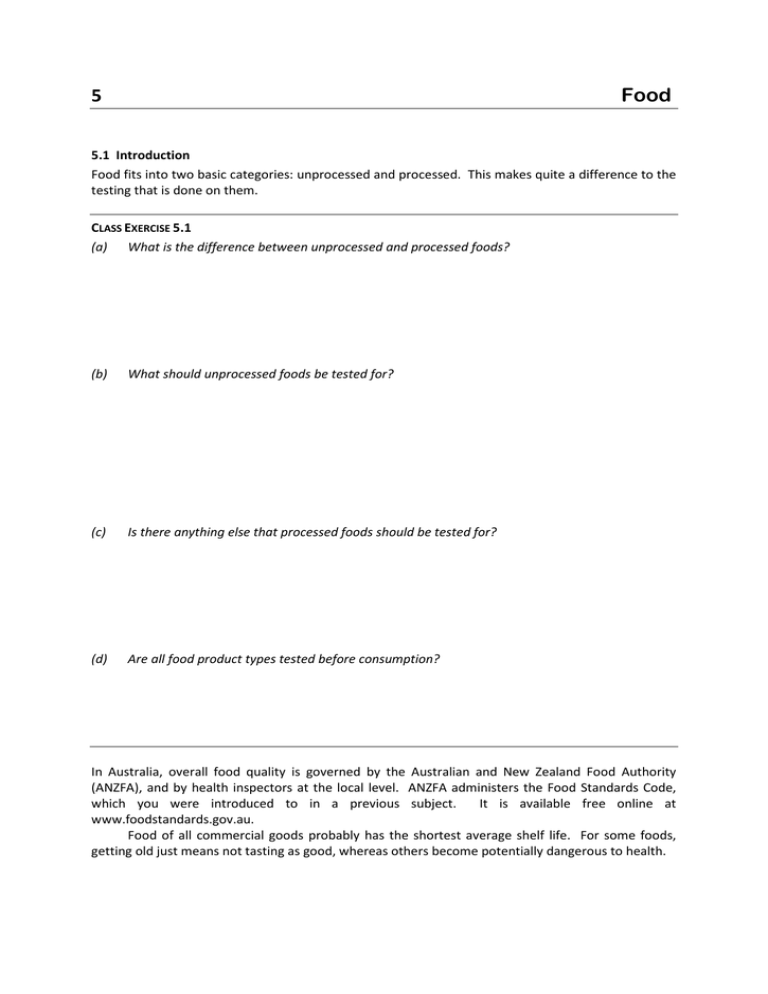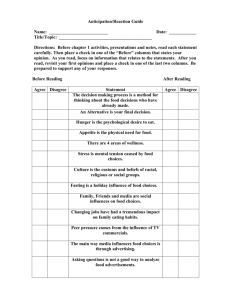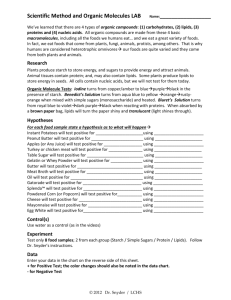Food 5
advertisement

Food 5 5.1 Introduction Food fits into two basic categories: unprocessed and processed. This makes quite a difference to the testing that is done on them. CLASS EXERCISE 5.1 (a) What is the difference between unprocessed and processed foods? (b) What should unprocessed foods be tested for? (c) Is there anything else that processed foods should be tested for? (d) Are all food product types tested before consumption? In Australia, overall food quality is governed by the Australian and New Zealand Food Authority (ANZFA), and by health inspectors at the local level. ANZFA administers the Food Standards Code, which you were introduced to in a previous subject. It is available free online at www.foodstandards.gov.au. Food of all commercial goods probably has the shortest average shelf life. For some foods, getting old just means not tasting as good, whereas others become potentially dangerous to health. 5. Food CLASS EXERCISE 5.2 What are some examples of foods that become (a) less tasty and (b) unsafe as they get older? (a) (b) As a consequence, the shelf life of a product, and the outcome of its ageing is part of the research and development process for a new food product. Labelling of packaged foods is strictly controlled by the Food Standards Code, and one part of that is the shelf life information, as shown below. Food Standards Code 1.2.5 The four possible shelf life indicators on packaged food in Australia are: • baked-for date – in relation to bread, means a date not later than 12 hours after the time the bread was baked • baked-on date – in relation to bread, means the date on which the bread was baked • best-before date – in relation to a package of food, means the date which signifies the end of the period during which the intact package of food, if stored in accordance with any stated storage conditions, will remain fully marketable and will retain any specific qualities for which express or implied claims have been made • use-by date – in relation to a package of food, means the date which signifies the end of the estimated period if stored in accordance with any stated storage conditions, after which the intact package of food should not be consumed because of health and safety reasons It is also compulsory for packaged food to have a unique identification code stamped on it so that if a problem occurs, it can be traced to a location, date and time of manufacture. It is not necessary that this code be interpretable by the general public, but the date stamp is often part of it. Foods with a lifetime of more than two years do not require a shelf life stamp. 5.2 Testing Almost all food, whether fresh or packaged, processed or unprocessed, is a complex mixture of various organic compounds and some inorganic mineral elements that should be there, and are a necessary part of the diet. Table 5.1 lists the most important examples of each. TABLE 5.1 Important food components Organic Inorganic protein calcium complex carbohydrates iron sugars sodium fibre potassium fats phosphate vitamins water Industrial Products (Testing) 5.2 5. Food Water By weight, water is the largest component of many foods, as shown in Table 5.2. Water is not a dietary necessity in terms of its intake through food. We need water to live, and get plenty in food, but that isn’t why it is important to test for its level. TABLE 5.2 Water content of common foods Food % Water Food % Water Food % Water Lettuce 95 Rice (raw) 10 Milk 90 Orange 85 Rice (cooked) 70 Soft drink 90 Banana 75 Bread 40 Ice cream 60 Steak 65 Cracker biscuits 5 Baked (canned) beans 70 CLASS EXERCISE 5.3 Why is it necessary to test for water? The oven drying method is by far the dominant method for moisture determination, partly because it is so simple. In some instances, the heating may be under vacuum to reduce decomposition by oxygen, or in a convection oven to maximise the efficiency of drying. CLASS EXERCISE 5.4 What are the limitations of the oven drying method? Where a particular food exhibits characteristics which mean its moisture determination cannot be accurately done by the oven method, other alternatives include: • gas chromatography • Dean & Stark • Karl Fischer titration Industrial Products (Testing) 5.3 5. Food CLASS EXERCISE 5.5 Which method would be best for the moisture determination of: (a) bread (b) honey (c) olive oil (d) vanilla essence Triglycerides and other lipids The major components of “fat” in foods is triglyceride. Too much triglyceride in the diet causes obesity, and can also lead to high cholesterol levels and the associated heart problems. Unsaturated triglycerides – those with some C=C in the acid chains – are better than saturated ones. CLASS EXERCISE 5.6 What is the structure of a typical triglyceride? There are many methods available for the determination of fat in foods. Applicability of the methods vary greatly depending on the physical state of the food. One of the simplest methods of determining fat is the solvent extraction procedure. The sample is exposed to continuous extraction by an organic solvent such as trichloromethane for 1-2 hours. This procedure is acceptable for substances such as biscuits and potato chips, but fails for other substances such as some dairy products. The total amount of fat in a food is important, but so is the composition, in terms of the level of unsaturation in the fatty acid chains. There is a major problems in directly analysing the individual components of the fats in a foodstuff: there are 10-20 different fatty acids found in triglycerides and three per triglyceride, so the number if possible combination is huge, meaning that it is not possible to separate the fats whilst in the triglyceride form. It is possible to obtain a "fat profile" by the Fatty Acid Methyl Ester Method (FAME). This method involves: 1. hydrolysis of the triglycerides in methanolic KOH to produce the fatty acid salts 2. conversion of the fatty acids to their corresponding methyl esters using methanol and the catalyst BF3 3. analysis of the esters by GC Industrial Products (Testing) 5.4 5. Food CLASS EXERCISE 5.7 (a) Write the equations for steps 1 & 2. (b) Explain why this gets around the problem described for the triglycerides. For triglyceride-rich foods, such as butter, margarine and cooking oils, there are two simpler, but less specific tests that give related information to the FAME method. These are the saponification value and the iodine number. The saponification value (SV) is determined by hydrolysing the triglycerides under reflux with a known amount of KOH. This excess KOH is back-titrated with standardised HCl. The SV is the mass of KOH in mg that reacts with 1 g of food. This may not seem a terribly useful value, but it give a number that is related to the average chain length of the fatty acids in the sample. How does it do this? It requires 3 moles of KOH to hydrolyse one mole of triglyceride. if that triglyceride is made up of three C20 fatty acid chains, it will have a higher mass than one which has three C10 chains in it. Therefore, a sample with a higher than average chain length of the fatty acids will have fewer moles of triglyceride per gram of sample, and therefore require less KOH/gram. Therefore the saponification value is highest for shorter average chain lengths and vice versa. The iodine number (IN) is determined by reacting the triglycerides with iodine monochloride (Wij’s reagent) in the dark for 1 hour. Any C=C will undergo an addition reaction with the ICl. The excess ICl is then back-titrated with standardised sodium thiosulfate, reacting in the same way as iodine does. The IN is the mass of iodine that reacts with 100 g of sample. It could be calculated as a number of C=C per 100g, but it isn’t. The higher the IN, the greater the number of double bonds, and the more unsaturated the triglyceride is. Proteins Proteins are essential dietary components for a number of reasons, foremost being the supply of amino acids to make other proteins (eg muscle fibre) and enzymes in the body. CLASS EXERCISE 5.8 What is the structure of a typical protein? Industrial Products (Testing) 5.5 5. Food Several methods exist for the determination of protein in food, but the most commonly used procedure is the Kjeldahl nitrogen method. Near infrared spectroscopy (NIR) is also used. The Kjeldahl method is used extensively throughout all branches of analytical chemistry where the nitrogen content is required. It can be done with relatively standard equipment (though special digesters and distillation apparatus are much more efficient, and expensive). It is the standard method for protein analysis in almost all biological materials. The procedure involves oxidising the sample in hot concentrated sulfuric acid (with a copper sulfate catalyst and sodium sulfate to increase the boiling point), which converts the bound nitrogen into ammonium ions. The addition of strong base to the solution converts the ammonium ions to ammonia gas, which may then be collected and titrated, as shown in Figure 5.1. oxidation Protein N Ammonium NH4+ neutralisation Ammonia NH3 distillation & titration FIGURE 5.1 The analytical sequence for the Kjeldahl method The ammonia may be collected in a known volume of standard acid, then a back titration performed or it may be collected in a solution of excess unstandardised boric acid (equation 5.1). The borate ion produced is a stronger base than ammonia and is titrated with standardised acid using bromocresol green indicator. HBO2 + NH3 → NH4+ + BO2- Eqn 5.1 This method thus determines the moles of ammonia produced by the oxidation of the sample., which in reality is of no interest at all. However, each mole of ammonia is produced from 1 mole of nitrogen atoms (excluding those in the form of nitrate or nitrite). Thus the %N can be determined. CLASS EXERCISE 5.9 Calculate the %N in a sample of meat if 1.0589 g of sample, after the Kjeldahl procedure, gave a titre of 15.8 mL of 0.103 M HCl. FW of N is 14. How does this help us with the protein content? As most proteins from a particular source (eg meat) contain a consistent proportion of nitrogen, conversion of %N to %protein simply requires a knowledge of the %N in protein of that source. The majority of proteins contain around one-sixth nitrogen, and the standard value for general protein is 6.25. Factors for particular proteins are available. CLASS EXERCISE 5.10 What is the % protein in the meat from Ex 5.9? Industrial Products (Testing) 5.6 5. Food Total protein in a sample can also be determined using a modification of the Biuret colour forming reaction. This is really only suitable for liquids such as the albumins in egg white. The sample is reacted with biuret reagent, the colour allowed to develop, then the absorbance of the sample measured at 550nm in a colorimeter. Carbohydrates Carbohydrates in food fit into three basic categories: • sugars – mono- and disaccharides are dominated by sucrose (table sugar), fructose and glucose; this provides an instant hit of energy but is “burnt” up very quickly • complex polysaccharides – mainly starch, which the body can digest and provides the source of stored energy in the body • fibre – principally cellulose, which the body is unable to digest, but which is vital for proper bowel function Quantitatively sugars and complex CHOs are not easy to measure. This is because there are a number of different species of very similar physical and chemical characteristics, and the lack of reagents that will target these species. Methods for analysis depend rather on the type of food, and include: • optical rotation – best for relatively concentrated and pure forms, such as honey and boiled sweets, and can used to measure reducing and non-reducing sugars • HPLC or GLC – to determine the levels of individual sugars; in the case of GLC, the sugars must be converted in a volatile form, often by reaction with a silicon compound • enzymatic reaction – perhaps the most reliable, because different enzymes can be found to react with specific sugars; generally, a colour-forming reagent will be incorporated in the procedure, so that the analytical measurement is absorbance Fibre is classified as crude or dietary. The former is the simple one to measure, but overstates the amount of fibre available to the body in food. Dietary fibre is measured by an enzymatic method, while crude fibre involves a series of steps intended to remove all “digestible” material – fat, protein, soluble salts, sugars, starch – from the food, leaving only the fibre and insoluble minerals. These digestion steps are: • extraction with a non-polar solvent such as hexane • hydrolysis with H2SO4 • hydrolysis with NaOH The residue from this procedure is then filtered off, placed in a crucible and thoroughly dried in an oven at 110° C. After weighing, the residue is ashed in a muffle furnace. The crude fibre is reported as the loss in weight in the ashing process. Organic contaminants The most likely contaminants of this type are pesticides, and will be analysable by GC or HPLC after extraction from the food. Minerals In most cases, the organic matrix of the food will need to be destroyed before analysis of the mineral content is possible. This is because the mineral is bound up in the organic matter, or because the organic matter will cause a chemical or physical interference in the analysis. To remove the organic matrix requires either wet or dry ashing. In most cases, this will be the latter, using the Kjeldahl digestion process, using boiling sulfuric acid. Industrial Products (Testing) 5.7 5. Food Once ashed and diluted with water, the food is now no different to any other aqueous solution containing various metallic ions. It can be analysed by flame photometry (for Na & K), flame AAS or ICP emission (for natural levels of Ca, Mg, Fe, Zn etc) or electrothermal AAS for ultra-trace levels of impurities such as lead and mercury. The most important non-metallic inorganic species are chloride and phosphate. The former can be titrated with silver nitrate at high concentrations, or by ion chromatography at lower levels. The latter used to be measured spectrophotometrically, but can be now be done much more easily by ICP emission. What You Need To Be Able To Do • • • outline the reasons for testing foods explain the shelf life labelling requirements describe the common methods for testing organic and inorganic components of food Industrial Products (Testing) 5.8



